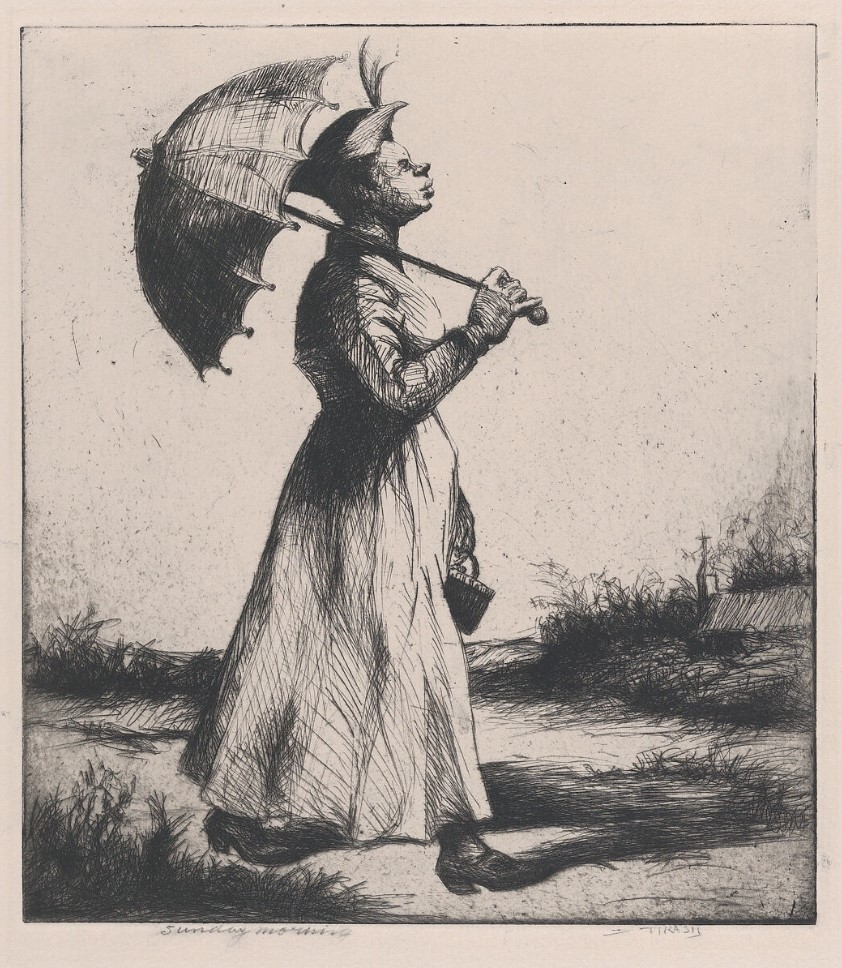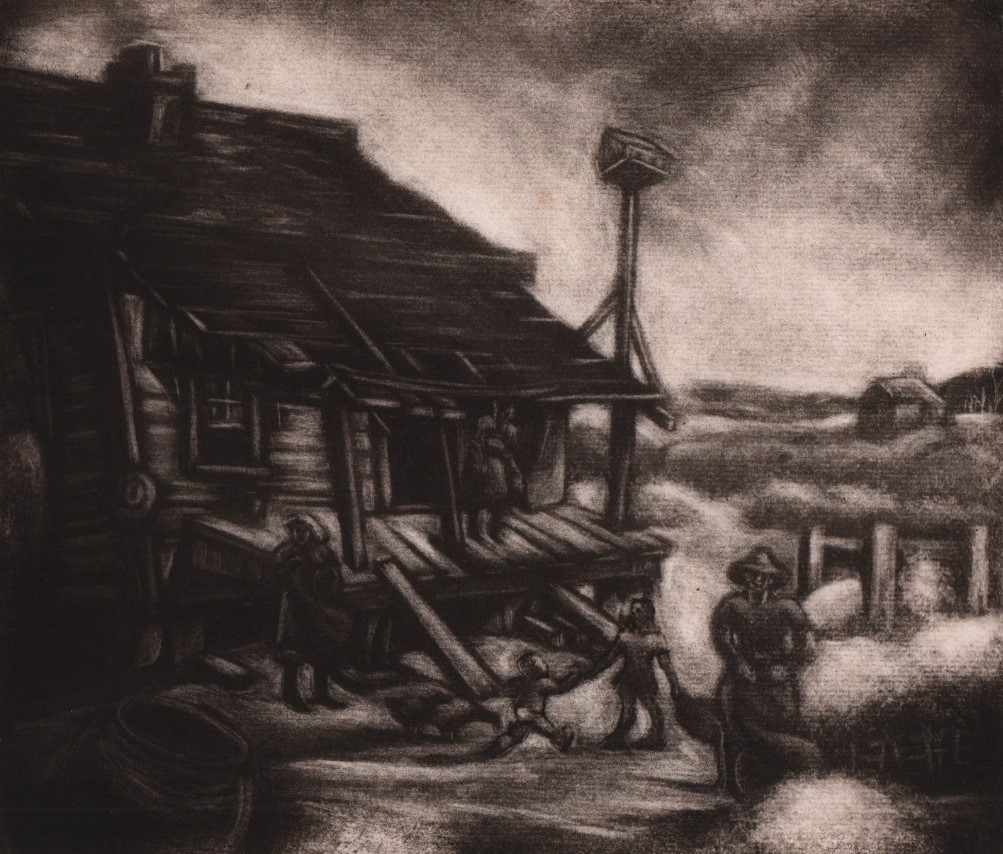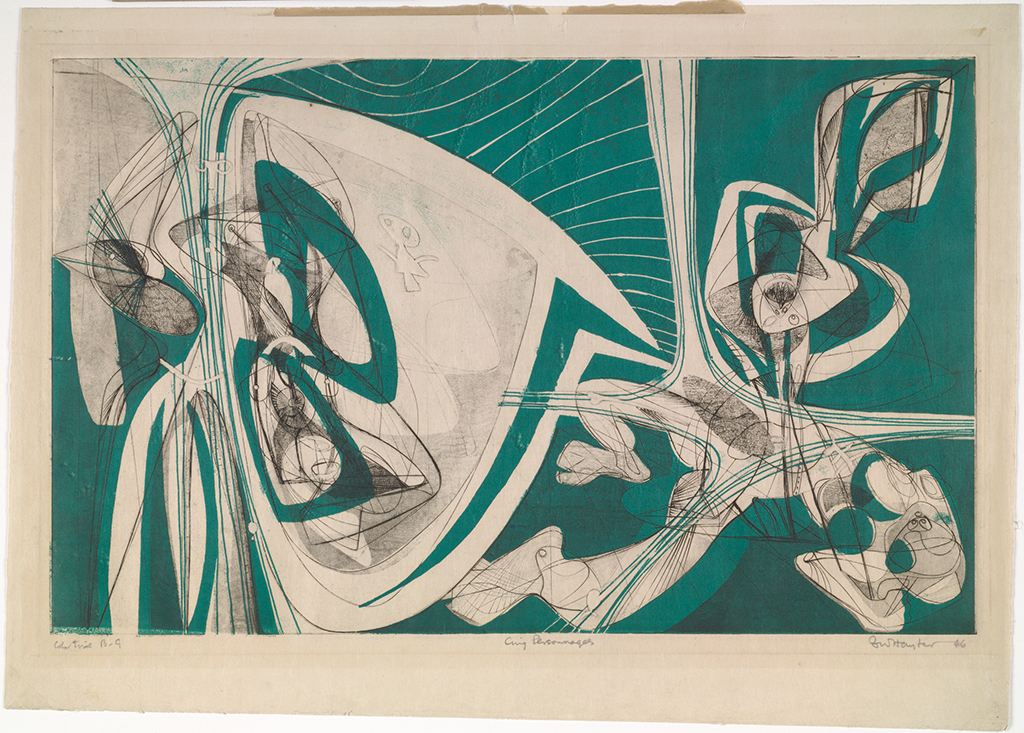s3e60 deep dive on Dox Thrash with dealer Ron Rumford
Platemark: Prints and the Printmaking Ecosystem
Release Date: 07/02/2024
 s3e83 solarplate etching with Dan Welden
s3e83 solarplate etching with Dan Welden
Platemark: Prints and the Printmaking Ecosystem
In this episode of Platemark, Ann sits down with the legendary artist and printmaker Dan Welden. The artist is known for his pioneering work in solarplate etching, a revolutionary, chemical-free printmaking process. Welden recounts his experiences and collaborations with significant artists like Eric Fischl and Elaine and Willem de Kooning. He also delves into his personal creative struggles, preferences for classical music, and tales of his distinctive handmade house filled with artist tiles and unique craftsmanship. The episode is a compelling insight into Welden's artistic journey...
info_outline s3e82 topology- and philosophy-imbued domestic scenes with Ellen Heck
s3e82 topology- and philosophy-imbued domestic scenes with Ellen Heck
Platemark: Prints and the Printmaking Ecosystem
In this episode of Platemark, I talk with Ellen Heck about her artistic journey and work. We talk about the intricacies of printmaking techniques, Ellen's various portrait series, and the conceptual ideas behind her work. Ellen shares her journey from studying philosophy at Brown, to printmaking at the School of the Art Institute of Chicago, and finally working at the Kala Art Institute in Berkeley. They also explore topics like the influence of Mary Cassatt, the use of color wheels in organizing compositions, and Ellen's fascination with topology in her artwork. Our insightful conversation...
info_outline s3e81 building and fixing presses with Mike Stark
s3e81 building and fixing presses with Mike Stark
Platemark: Prints and the Printmaking Ecosystem
In this episode of the Platemark, I interview Mike Stark, the co-founder and owner of Stark Press Company. The New Jersey-based company, run by Mike and his brother Tom, builds new presses, services old presses, and aids in moving them. They often collaborate with Perry Tymeson, a legendary press repairman. Mike shares insights into designing new presses, managing a small business, and balancing creative work. We talk about studying print media at SAIC in Chicago and establishing Stark Press. We talk about his experiences in moving heavy presses, sometimes in challenging conditions, and the...
info_outline s3e80 melding printing and publishing with curatorial work with Mae Shore
s3e80 melding printing and publishing with curatorial work with Mae Shore
Platemark: Prints and the Printmaking Ecosystem
In this episode of Platemark, I talk with Mae Shore, a collaborative printer and owner of Shore Publishing in Tuxedo Park, New York. Mae shares her experiences working at Pace Editions with notable artists like Jim Dine and Chuck Close. She discusses the history and evolution of her gallery and print shop, which she established to merge her love for printmaking and curating exhibitions. Mae touches upon specific projects, such as her collaborations with artists like Amy Bennett, Kamrooz Aram, and Katia Santibañez and James Siena, detailing the unique processes and challenges in creating...
info_outline s3e79 contemporary Japanese prints with Michael Verne
s3e79 contemporary Japanese prints with Michael Verne
Platemark: Prints and the Printmaking Ecosystem
In this episode of Platemark, I talk with Michael Verne, the owner of the Verne Collection in Cleveland, Ohio. Mike's gallery specializes in contemporary Japanese art and works by American artists residing in Japan. We talk about the challenges and rewards of running a small gallery amid larger competitors, and the importance of finding and promoting new artists. Mike shares insights about his journey in the art world, from his childhood surrounded by art to becoming a successful gallerist without a formal art education. He recounts various personal anecdotes, including his experiences at art...
info_outline s3e78 electronic arts in printmaking with Myles Calvert
s3e78 electronic arts in printmaking with Myles Calvert
Platemark: Prints and the Printmaking Ecosystem
In this episode of Platemark, Myles Calvert, a printmaker and professor, shares his extensive journey from growing up in Ontario, Canada, to studying and working in the UK, and eventually returning to Alfred University in New York, to become director of the Institute of Electronic Arts. Myles discusses his experiences working at prestigious galleries in London, giving up a tenure-track position, and the pivotal moments that shaped his career. He delves into his role as the Director of IEA at Alfred, including the intricacies of managing residencies, the use of technology in printmaking, and...
info_outline s3e77 documenting the printmaking ecosystem with Susan Goldman
s3e77 documenting the printmaking ecosystem with Susan Goldman
Platemark: Prints and the Printmaking Ecosystem
In this interview with the director and founder of Lily Press and the Printmaking Legacy Project, Susan Goldman shares her passion for printmaking and documentary film making. Susan discusses her journey from discovering printmaking at Indiana University, Bloomington, to founding Lily Press and creating impactful documentaries like Midwest Matrix. She highlights her educational experiences, mentors, and the vibrant printmaking community she's built over time. Goldman also delves into her personal work, her love for screenprinting, and the balance of managing a studio while collaborating with...
info_outline s3e76 the print studio as sanctuary with Bryan Raymundo
s3e76 the print studio as sanctuary with Bryan Raymundo
Platemark: Prints and the Printmaking Ecosystem
In this episode, Ann talks with Bryan Raymundo, owner of the Black Fragment Press. They discuss their meeting at the Mid America Print Council conference and Bryan’s background, from growing up in Mexico and Kansas to his love for Black Sabbath and printmaking. Bryan reveals his journey into art, inspired by comforting his sick grandmother with drawings, and his challenges in balancing his family’s immigrant expectations with his artistic aspirations. They delve deeply into his evolving art practice, the importance of mentors like Marco Hernandez and Jason Scuilla, and his passion for...
info_outline s3e75 posters vs prints with Angelina Lippert
s3e75 posters vs prints with Angelina Lippert
Platemark: Prints and the Printmaking Ecosystem
In this episode of Platemark, Ann sits down with Angelina Lippert, a poster historian and the curator and director of Poster House, to discuss the inception and growth of the first museum in the U.S. dedicated exclusively to the art and history of posters. They talk about what makes posters and fine art prints the same and different. And they discuss the challenges and processes of acquiring, preserving, and showcasing posters, the historical and cultural significance of early advertising posters, and the often-overlooked artistry involved in their creation. Platemark Sign-up for...
info_outline s3e74 Dürer's connection to the Islamic East with Susan Dackerman
s3e74 Dürer's connection to the Islamic East with Susan Dackerman
Platemark: Prints and the Printmaking Ecosystem
In this episode of Platemark, Ann talks with Susan Dackerman, a curator and art historian specializing in Northern European print culture. They discuss Susan's recent book, Dürer's Knots: Early European Print and the Islamic East, which looks at the artist's relationship to the Islamic world, revealing groundbreaking insights about the intersection of early modern printmaking and contemporary history. Susan's book covers three of Dürer's prints or print series. The first section looks at The Sea Monster (Das Meerwunder), c. 1498, and postulates that it chronicles the return to Venice...
info_outlineAfrican-American artist Dox Thrash is in the spotlight on s3e60 of Platemark. Podcast host Ann Shafer speaks with Ron Rumford, director of Dolan/Maxwell, a private gallery in Philadelphia, which has a particular specialty in the prints of Stanley William Hayter and the associated artists of Atelier 17, as well as Black artists of the same era, such as Dox Thrash, Bob Blackburn, Norma Morgan, Elizabeth Catlett, Ed Clark, and more. Ron was eager to highlight an exhibition focused on Dox Thrash, which is on view at the African American Museum of Philadelphia through August 4, 2024.
They talk about Thrash and his invention of the carborundum mezzotint, Bob Blackburn’s Printmaking Workshop and its relationship to Atelier 17 and Hayter, the monumental importance of the WPA printmaking division, and Ballinglen, an artist residency and gallery founded by Peter Maxwell and Margo Dolan in Ballycastle, a tiny farming town in County Mayo, Ireland.
Dox Thrash (American, 1893–1965). Sunday Morning, c. 1939. Etching. Sheet: 12 5/8 x 10 5/8 in.; plate: 8 7/8 x 7 7/8 in. Metropolitan Museum of Art, New York.
L-R: Krishna Reddy, Stanley William Hayter, Robert Blackburn, and friend, 1980s, at Reddy’s studio.
Hayter at the press with lithography press behind him, Atelier 17 in New York.
Photo of Pennerton West with fellow artists including Augusta Savage and Norman Lewis.
Pennerton West (American, 1913–1965). Troll in the Grain, 1952. State proof; color etching and lithography. Image: 14 ¾ x 17 ¾ in. Dolan/Maxwell Gallery, Philadelphia.
Pennerton West (American, 1913–1965). Troll in the Grain, 1952. State proof; color etching and lithography. Image: 14 ¾ x 17 ¾ in. Dolan/Maxwell Gallery, Philadelphia.
Dox Thrash (American, 1893–1965). Georgia Cotton Crop, c. 1944–45. Carborundum mezzotint. Plate: 8 7/16 x 9 7/8 in.; sheet: 11 ¼ x 11 3/4. in. Dolan/Maxwell Gallery, Philadelphia.
Dox Thrash (American, 1893–1965). Ebony Joe, c. 1939. Lithograph. Sheet: 10 5/8 x 8 7/8 in. Saint Louis Art Museum, St. Louis.
Dox Thrash (American, 1893–1965). Octoroon (Study for a Lithograph), c. 1939. Brush and ink wash over graphite. Sheet: 16 7/8 x 12 ¼ in. Philadelphia Museum of Art, Philadelphia.
Dox Thrash (American, 1893–1965). Octoroon, c. 1939. Lithograph. Sheet: 22 13/16 x 11 9/16 in. Collection of John Warren, Philadelphia.
Dox Thrash (American, 1893–1965). Charlot, c. 1938–39. Carborundum mezzotint. Plate: 8 15/16 x 6 15/16 in. Dolan/Maxwell, Philadelphia.
Michael Gallagher (American, 1895–1965). Lackawanna Valley, 1938. Carborundum mezzotint. Plate: 7 3/8 x 12 11/16 in.; sheet: 9 3/8 x 14 in. Philadelphia Museum of Art, Philadelphia.
Hugh Mesibov (American, 1916–2016). Homeless, 1938. Carborundum mezzotint. Plate: 5 3/8 x 10 3/8 in. Pennsylvania Academy of Fine Arts, Philadelphia.
Dox Thrash (American, 1893–1965). One Horse Farmer, c. 1944–48. Carborundum mezzotint. 9 x 6 in. National Museum of American History, Smithsonian Institution, Washington, D.C.
John Ruskin (British, 1819–1900). The Garden of San Miniato near Florence, 1845. Watercolor and pen and black ink, heightened with whie gouache, over graphite. Sheet: 13 7/16 x 19 3/8 in. National Gallery of Art, Washington, D.C.
Stanley William Hayter (English, 1901–1988). Cinq personnages, 1946. Engraving, softground etching, and scorper; printed in black (intaglio). Sheet: 495 x 647 mm. (19 1/2 x 25 1/2 in.); plate: 376 x 605 mm. (14 13/16 x 23 13/16 in.). Baltimore Museum of Art, Baltimore.
Stanley William Hayter (English, 1901–1988). Cinq personnages, 1946. Engraving, softground etching, and scorper; printed in black (intaglio), and green (screen, relief). Sheet: 460 x 660 mm. (18 1/8 x 26 in.); plate: 376 x 605 mm. (14 13/16 x 23 13/16 in.). Baltimore Museum of Art, Baltimore.
Stanley William Hayter (English, 1901–1988). Cinq personnages, 1946. Engraving and softground etching; printed in black (intaglio), orange (screen, relief), and purple (screen, relief). Sheet: 510 x 666 mm. (20 1/16 x 26 1/4 in.); plate: 376 x 605 mm. (14 13/16 x 23 13/16 in.). Baltimore Museum of Art, Baltimore.
Stanley William Hayter (English, 1901–1988). Cinq personnages, 1946. Engraving, softground etching, and scorper; printed in black (intaglio), green (screen, relief), orange (screen, relief), and purple (screen, relief). Sheet: 488 x 668 mm. (19 3/16 x 26 5/16 in.); plate: 376 x 605 mm. (14 13/16 x 23 13/16 in.). Baltimore Museum of Art, Baltimore.
Ballinglen Arts Foundation, Ballycastle, County Mayo, Ireland.
USEFUL LINKS
Imprint: Dox Thrash, Black Life, and American Culture. African American Museum in Philadelphia, March 23–August 4, 2024.
https://www.aampmuseum.org/current-exhibitions.html
John Ittmann. Dox Thrash: An African American Master Printmaker Rediscovered. Philadelphia: Philadelphia Museum of Art, 2001. https://archive.org/details/doxthrashafrican00ittm
Dox Thrash House, Philadelphia: https://doxthrashhouse.wordpress.com/
Ballinglen Arts Foundation: https://www.ballinglenartsfoundation.org/fellowship/
Dolan/Maxwell’s IG: @dolan.maxwell
Ron’s IG account: @ron.rumford
Ron’s artist website: www.ronrumford.com




















